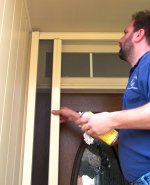Search engine visitors - click here to access entire "$ensible Home" web site
Click here to see a descriptive illustration of several types of retractable door screening kits.
Dear Jim: My old back screen door doesn't fit well and lets mosquitoes in. Also, I would like screens over the front door, but most screen doors are ugly. What options do I have for bug-free, efficient ventilation? - Jean D.

A: Improving ventilation instead of continuous use of air-conditioning can lower your utility bills and often improve indoor air quality. If more people had relied on natural ventilation last summer and controlled peak electricity demand for the utility companies and the power grid, perhaps the huge East Coast blackout could have been avoided.
Another advantage of having screens over doors with glass is you can install special sun-control screening. This fiberglass screening is easy to see out through and it provides adequate ventilation, but it can block up to 70 percent of the sun's heat. During the winter, the screen will slow down the direct force of winter winds and reduce the outdoor air infiltration through your doors.
You have three basic options for adding screening over your doors: 1) make your own screen panels, 2) install new decorative screen doors, or 3) install retractable screens that disappear. Installing tight-fitting screens is also more important than ever with so many cases of West Nile virus occurring from mosquito bites.
Several companies offer do-it-yourself screen framing kits which you can size to your existing door. The kits include frame extrusions, splines, springs, pull tabs and corner connectors. Check at your home center store.
Installing a new screen door is an effective option, but an expensive one. You might get by with a moderately priced (several hundred dollars) door for the back. For the front though, a more decorative high-quality screen door can cost $500 or more with installation. The better screen doors often also offer the options of sun-control or superstrong pet resistant screening panels.
A more reasonably priced option is adding retractable screens over your front and back doors. I installed a kit over my insulated carbon-fiber double front doors at my own home. Some designs are only dealer-installed, but others, such as mine, are available in do-it-yourself kits. When the screens are retracted, they are totally out of sight and out of the way. Many models have a lifetime warranty on everything except the screening fabric itself.
Most retractable screen systems operate in a similar manner. You attach a narrow tubular housing (cassette) vertically on the door frame and a latching channel on the other side. One small aluminum track is attached horizontally to the floor and one to the top of the door opening. A magnetic latch is built into the latching channel.
When you open your door for ventilation, pull the handle on the edge of the screen which is coiled up in the cassette. It unrolls from the cassette and latches on the other side with the magnetic latch. Some models use a mechanical latch for high wind conditions in high-rise apartment buildings. There is slight spring tension on the screening to keep it taut and attractive. On the do-it-yourself kits, the tension is adjustable.
There are quality differences among the various designs available. Replacement screening kits are available because any screen will wear out over time. Look for a long warranty. Since retractable screens can be mounted inside or outside the primary door where they are exposed to the weather, stainless steel hardware and aluminum extrusions are a definite plus.
Some kits use ball bearings in the cassette and pile lining in the grooves for smooth operation. Double latching magnets provides a sealed edge when closed. Durable reinforcing strips along the edge of the screen can increase its life substantially. Much of the wear on the screen occurs where it slides in the track.
There are somewhat similar designs of retractable screens for windows. These kits use a screen that automatically covers the window when you open it and retracts again when you close the window. This is effective for solar heating because the glass is not
covered with screen when you desire the sun's heat. Larger motorized retractable screens are available to cover an entire balcony or porch. These are only dealer-installed.
If you want to work bug-free and comfortably cool in your garage or want to use it as a screened-in "porch" for entertaining at times, install a garage door screen kit. The kits are available for doors up to 20 feet wide and eight feet high. The screen can be put up and removed quickly and there is a walk-through Velcro sealed door in the center of it.
Instant DownloadUpdate Bulletin No. 813 - buyer's guide of 12 add-on retractable door/window screening kit and special screening (heat/sun control, pet-resistant, etc.) manufacturers showing types, door sizes, colors, features, prices, and descriptive illustrations showing components of retractable screen kits, add-on porch and garage door screening kits.
Dear Jim: I probably should have my house treated for termites. Some of my neighbors' have termites, but I have not found any in mine. Are the repellent or nonrepellent types of termite treatment better? - Steve C.
A: If your neighbors' houses have termites, yours probably does also. You just have not found them yet. You should plan on spending from $1,000 to $2,000 to have your house treated properly.
The nonrepellent types of treatments, such as Premise and Termidor, are more effective because the termites crawl through it and then die. With repellent treatments, the termites sense it and may find a gap in the barrier around your foundation.